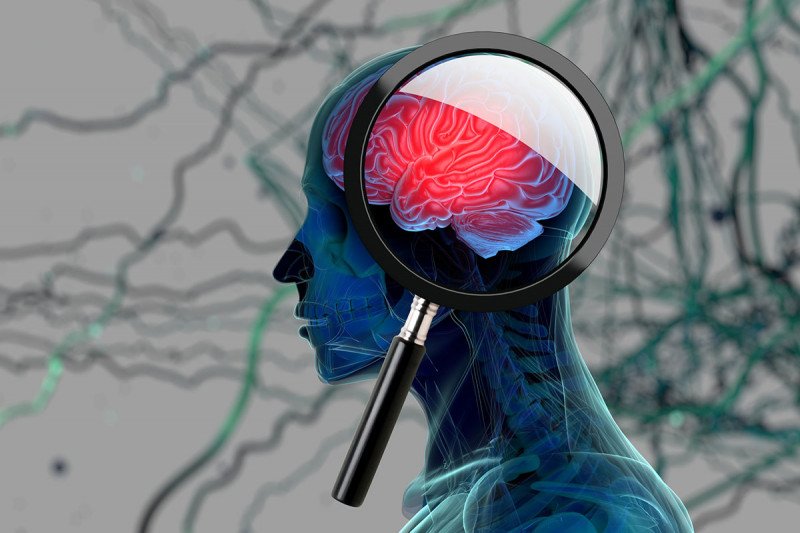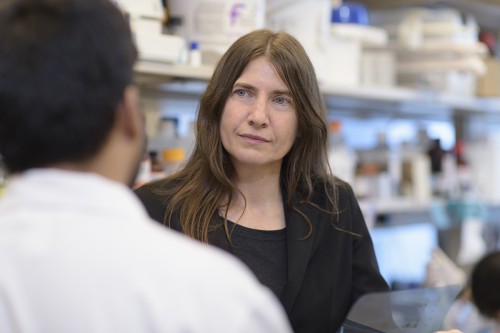
The body is presented with stressors throughout life. These stressors include genetic and environmental challenges that accumulate over time and damage cells, circuits, and organs. This can lead to a wide variety of maladies, including cancer and age-related brain disorders.
Sloan Kettering Institute scientist Gabriela Chiosis and her colleagues study the effects of stressors on proteins and the networks they make up in cells. In a new study published in Nature Communications, her team discovered how stress rewires key connections in the brain. These changes lead to malfunctions associated with Alzheimer’s disease. In addition, they demonstrated how a drug that’s currently being tested in clinical trials for Alzheimer’s, called PU-AD, may correct faulty wiring and preserve brain functions. In lab mice, the drug rewired circuitry within the hippocampus, the part of the brain associated with memory. The result was improved memory without any side effects.
“This study is the culmination of years of research in my lab,” Dr. Chiosis says. “It’s a paradigm-shifting way to think about Alzheimer’s.”
Identifying Common Factors in Cancer Biology and Alzheimer’s Disease for Therapeutics
In 2016, Dr. Chiosis led a study showing that in cancer cells, proteins called chaperones band together in response to stressors associated with cancer and form faulty networks. She named this faulty network of chaperones the epichaperome.
As their name implies, chaperone proteins take care of our cells. They help proteins get made and ensure that cellular activities are coordinated properly. The epichaperome, on the other hand, changes how proteins interact with one another. It causes them to improperly organize inside cells and accelerates the course of disease.
An experimental drug developed at MSK called PU-H71 targets these faulty epichaperomes when they form in cancer. Dr. Chiosis’s 2016 study found that the effectiveness of PU-H71 on tumors depends on how many chaperones have banded into epichaperomes: The more the chaperones have switched to become epichaperomes, the more effective PU-H71 was.
Looking for Epichaperomes in Alzheimer’s Disease
In the new study, Dr. Chiosis and her team analyzed brain tissue from people with Alzheimer’s disease. They compared these to tissues from people of the same age without Alzheimer’s. Higher numbers of chaperones banded into epichaperomes in brain tissue from people with Alzheimer’s compared with healthy brain tissue. These findings were validated in multiple mouse and cellular models of Alzheimer’s disease.
Alzheimer’s is a progressive neurodegenerative disease with complex causes. Many stressors can contribute to it, including diabetes, stroke, high blood pressure, and traumatic brain injury. Genetic risk factors and other age-related changes can also damage brain circuitry over decades. “We decided to look at whether this complex matrix of stressors that change the brain is related to epichaperome formation,” Dr. Chiosis says.
This turned out to be the case. Her team found that in the Alzheimer’s brain tissue, epichaperomes assisted the incorrect organization of many proteins required for normal brain function, including memory and higher-order executive function. Faulty disorganization of memory-related proteins seemed to cascade into defective communication between neurons. That disruption ultimately led to brain dysfunction.
“These changes were similar to network failures seen in electrical or mechanical components that eventually lead to system failure and shutdown,” explains Dr. Chiosis, a member of SKI’s Chemical Biology Program. “The epichaperome acts like a scaffold that allows the misconnectivity of proteins, and in turn, neuronal circuits collapse and underlie age-related cognitive dysfunction.”
Based on their discoveries, Dr. Chiosis and her colleagues, including neuroscientists at Weill Cornell Medicine, the New York University School of Medicine, and the Nathan Kline Institute for Psychiatric Research, developed a term to describe this phenomenon: protein connectivity–based dysfunction (PCBD). “Many people who study Alzheimer’s are thinking about circuits in the brain. But there’s no clear understanding of how stressors due to aging and the environment change the way proteins interact,” she says. “Our research demonstrates that epichaperome formation rewires brain circuitry in Alzheimer’s by enabling proteins to misconnect, leading to downstream PCBD and cognitive decline.”
Validating Findings in Animal Models of Disease
Armed with this knowledge about epichaperomes, Dr. Chiosis and her team treated a mouse model of Alzheimer’s with PU-AD. Like PU-H71 in cancer, PU-AD uncouples the faulty protein networks created by epichaperomes. They found that PU-AD corrected how proteins interacted in the mice. The drug was able to fix signaling problems between neurons. The treated brains resembled those of normal mice.
Further research showed that after Alzheimer’s mice were given PU-AD, they performed much better in tests that evaluate memory function. They also survived longer than mice given a placebo. This indicates that the drug treatment was safe and effective.
The first clinical trial of PU-AD launched in 2019 to confirm in healthy volunteers that the drug is safe. PU-H71 is already in clinical trials for lymphoma, breast cancer, and other cancers. That drug appears to be safe, and researchers are optimistic that the same will hold true for PU-AD. PET imaging versions of both drugs are also being studied in clinical trials as a way to track changes in cells and PCBD in living patients, with the hope that the drug treatment reverses damage in real time.
Summing up the findings in such diverse disorders as cancer and Alzheimer’s disease, Dr. Chiosis says, “Epichaperomes are disease hallmarks that we are just beginning to understand. The idea that we might be able to target this whole network with drugs and treat such complex diseases as cancer and Alzheimer’s is pretty remarkable.”





